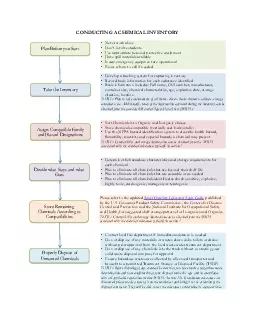

Never work aloneDont involve studentsUse appropriate personal protective equipmentHave spill materials availableInsure emergency equipment are operationalKnow whom to call if neededDevelop a tracking ID: 887888
Download Pdf The PPT/PDF document "CONDUCTING A CHEMICAL INVENTORY" is the property of its rightful owner. Permission is granted to download and print the materials on this web site for personal, non-commercial use only, and to display it on your personal computer provided you do not modify the materials and that you retain all copyright notices contained in the materials. By downloading content from our website, you accept the terms of this agreement.
1 CONDUCTING A CHEMICAL INVENTORY
CONDUCTING A CHEMICAL INVENTORY Never work alone Don’t involve students Use appropriate personal protective equipment Have spill materials available Insure emergency equipment are operational Know whom to call if needed Develop a tracking system for capturing inventory Record basic information for each substance identified Basic information includes: Full name, CAS number, manufacturer, container size, chemical characteristics, age, expiration date, storage situation, location. NOTE: Plan to take an inventory of all rooms, clo sets, desks, drawers, cabinets, storage containers, etc. Additionally, much of the information captured during the inventory can be obtained from the associated Material Safety Data Sheet (MSDS) Sort Chemicals into Organic and Inorganic classes Store chemicals compatibly (vertically and horizontally) Use the NFPA hazard identification system to describe health hazard, flamability, reactivity and especial hazards a chemical may present NOTE: Compatibility and storage information can be obtained from the MSDS associated with the chemical substance; typically in section 7 Determine the hazardous characteristics and storage requirements for each chemical Plan to eliminate all chemicals that are beyond their shelf life Plan to eliminate all chemicals that are unusable or unneeded Plan to eliminate all chemicals identified as shock sensitive, explosive, highly toxic, carcinogenic, mutagenic or teratogenic Please refer to the updated School Chemistry Laboratory Safety Guide , published by the U.S. Consumer Product Safety Commission , the Centers for Disease Control and Prevention and the National Institute for Occupational Safety and Health, for suggested shelf storage patterns for Inorg anics and Organics. NOTE: Compatibility and storage information can be obtained from the MSDS associated with the chemical substance; typically in section 7 Contact local fire department if immediate assistance is needed Do not dispose of any materials or wastes down sinks toilets or drains without prior approval from the local w aste water treatment department Do not dispose of any chemicals into the trash without contacting your solid waste disposal company for approval Ensure hazardous wastes are colle cted by a licensed transporter and brou g ht to a permitted Treatment Storage or Disposal Facility (TSDF) NOTE: Before disposing of any chemical be sure that you have made a hazardous waste determination and have confirmed that your disposal method is safe a nd in compliance with all applicable regulations (review MSDS, Section 13). If unknown substances are discovered, please make a note of it on the worksheet and bring it to the attention of the disposal contractor. They will be able to test the substance to determine its characteristics. Plan Before you Start Take the Inventory Assign Compatible Family and Hazard Designations Decide what Stays and what Goes Store Remaining Chemicals According to Compatibilities Properly Dispose of Unwanted Chemicals